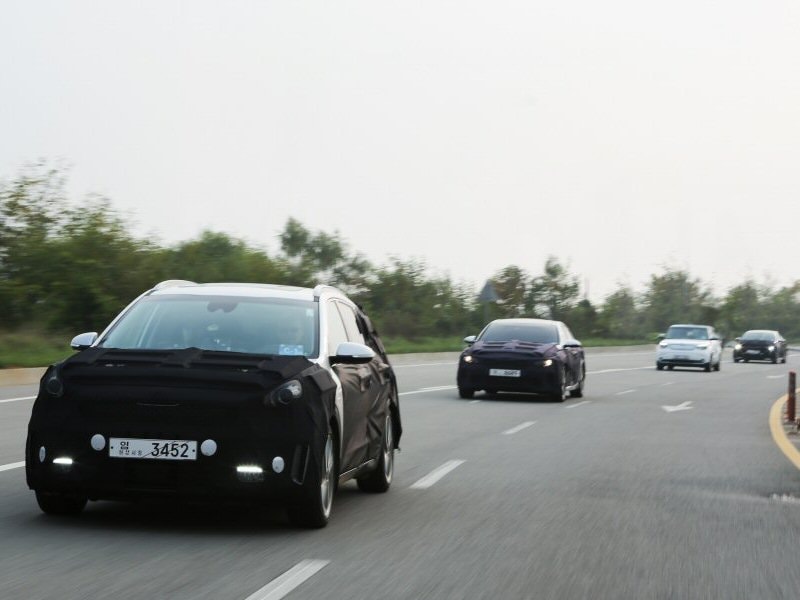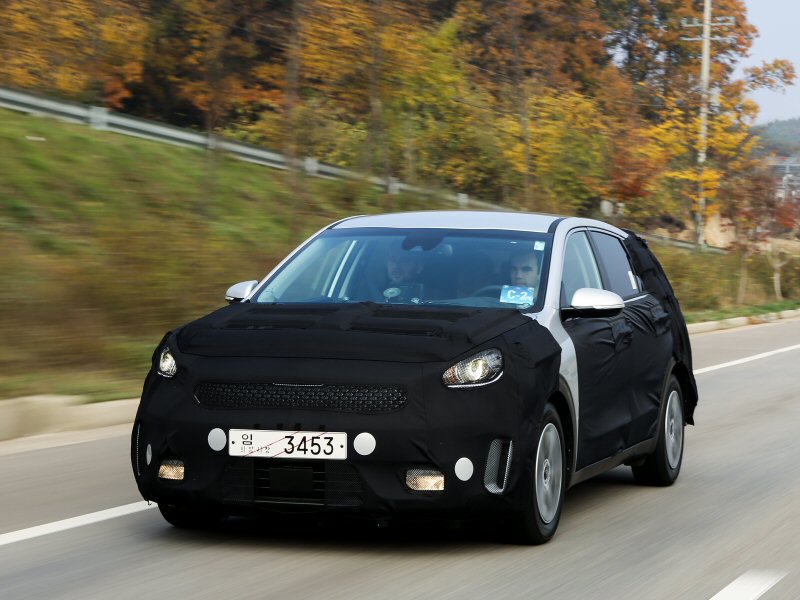Recent Articles
Popular Makes
Body Types
Kia Niro Hybrid First Drive and Review

Kia Niro Hybrid front 3/4 action on-road ・ Photo by Kia Media
Big things sometimes come wrapped in small packages. The announcement from Kia that it will be bringing its first dedicated hybrid to the United States is an important one, but the vehicle itself - the Kia Niro - sails into the compact utility vehicle segment riding on a modestly-sized platform paired with equally conservative styling. Don't let the Niro's commuter-friendly looks fool you: Kia has spent the last three years cramming the tall-riding hatchback with the latest and greatest hybrid technologies in a bid to at least get the attention of would-be class-leading Toyota Prius buyers. After spending the afternoon behind the wheel of the Kia Niro on roads surrounding the automaker's Namyang research and development center on the outskirts of Seoul, Korea, it's clear that Kia is paying more than lip service to its Prius-poaching goal. If priced right, the Niro's crossover-like practicality, phenomenal promised fuel mileage, and SUV looks have the potential to carve out a slice of the compact hybrid market at the expense of its Toyota target.
The Kia Niro Is The First Dedicated Hybrid From The Brand
Although Kia has offered a hybrid version of its Optima sedan for the past several years, the Niro is the first vehicle from the brand to be developed from the ground-up as a dedicated hybrid. This means that the Kia Niro sports it own unique platform, and one that the automaker's engineers assured me won't be appropriated for any other automobiles in the future. By developing every aspect of the Niro to maximize its potential as a hybrid vehicle, Kia was able to achieve advances in efficiency, drivetrain smoothness, and packaging. It also indicates just how much of an investment the company was willing to make in its battery-assisted future by pouring big dollars into a single-use platform intended to go head-to-head with the hybrid segment's 800 lb gorilla: the Toyota Prius.

Photo by Kia Media
The Kia Niro Is Smaller (And Bigger) Than Its Two Main Prius Rivals
Despite being intended to snipe away at Prius customers, Kia wisely decided not to make the Niro a simple clone of the best-selling hybrid. Instead, the Kia Niro approaches the gasoline/electric compact question from an entirely different angle that draws heavily from the seemingly endless public thirst for small crossover vehicles. Although shorter than both the Prius, the Niro shares the same wheelbase, which means passenger room is comparable. More importantly, the Kia is wider and taller than even the plus-size Prius V, which gives it a more imposing presence on the road. It's interesting to note than the Niro actually posts a slightly longer wheelbase than the brand's Sportage SUV, which in my mind makes it a potential replacement for the automaker's now-departed Rondo compact people mover.

Photo by Benjamin Hunting
The Kia Niro's Drivetrain Features Cutting-Edge Eco Technology
Rather than install an off-the-shelf hybrid system, Kia has given the Niro a unique setup all its own. The small utility vehicle is motivated by a 1.6-liter, direct fuel injection four-cylinder engine that is paired with a single electric motor. Still in the prototype stage, Kia wasn't willing to commit to a total system horsepower number, but the engineering team behind the Niro did reveal that the 1.6-liter pushes out just over 100 horsepower and roughly 110 lb-ft of torque, and that the electric motor further adds about 50 additional ponies. Taking into account drivetrain loss, a figure of 140 combined horsepower felt about right during my time out on the road in the Niro, with acceleration coming gradually but certainly no pokier than similarly-spec'd hybrids. Tying everything together is a 1.56 kWh lithium-ion battery pack that facilitates limited electric-only operation at low speeds.

Photo by Kia Media
The Kia Niro Flips The Hybrid Script With A DCT
The secret sauce soaked into the Kia Niro's bespoke hybrid system is a dual-clutch automated manual transmission, a design that's almost unheard of in the affordable eco-car segment and another first for Kia. Moving to a DCT instead of the ubiquitous continuously-variable automatic gearbox design offered with most hybrid cars allowed Kia to take advantage of the mechanical efficiencies inherent in a dual-clutch setup, and it also served to improve the drivability of the vehicle. Rather than a hazy mist of power delivery the Niro offers smooth, distinct gear changes with the pedal to the floor, which goes a long way towards making the car feel a lot more like a normal, gas-only crossover than a true hybrid while commuting. There's even a shift-it-yourself feature built into the console-mounted gear selector, but it's more of a novelty than anything else (especially since the Niro doesn't come with a tachometer).

Photo by Kia Media
The Kia Niro Is Poised To Post Prius-Challenging MPGs
Remember earlier when I said that Kia's investment in a dedicated hybrid platform would maximize the Niro's efficiency potential? The numbers add up: although official EPA certification is pending, Kia is aiming for better than 50-mpg in combined driving from its utility hybrid, a figure that seems completely attainable given the Niro's specifications. This would push the car past the Ford C-Max Hybrid hatchback and put it on par with the Prius, giving it the technical ammunition it needs to impress the subset of buyers who make all their purchasing decisions based entirely on fuel consumption figures. One caveat: Kia has had issues in the past with real-world fuel efficiency not matching the official line, although with the emergence of the new Optima Hybrid (and its Hyundai Sonata Hybrid sibling) that seems to be a thing of the past.

Photo by Benjamin Hunting
The Kia Niro's Styling Is Surprisingly Subdued
A big part of Kia's recent identity has been a focus on styling, and in particular on being able to deliver interesting-looking cars at very affordable prices. Before the camouflage went on for our extremely public drive, and after our cameras and mobile phones were confiscated by worried-looking Koreans, the Kia Niro was showed off to us in its birthday suit. It's hard to characterize anything memorable about the hatchback's sheet metal, which is surprising given that it will be sitting in showrooms alongside eye-catching members of the Kia family like the Soul and the Optima. The most attitude on offer from the Niro is up front where it features the angled grille opening that has become a Kia trademark, as well as the just-for-show ground clearance (there's no AWD available, although it's technically feasible for future editions). The rest of the car is well-proportioned and certainly not ugly, but that's faint praise in face of Kia's traditional design chops. Of course, compared to the recently-redesigned, over-the-top Prius, the Niro looks like it's wearing a well-tailored Brooks Brothers suit, so maybe the reassuring familiarity of the vehicle's utility-focused shape is entirely the point.

Photo by Kia Media
The Kia Niro Is Aimed At Your Daily Commute
Overall it's hard to fault the Kia Niro from a driving dynamics standpoint. Its handling is well in keeping with similarly-sized hatchbacks, which means confident cornering and good stability on rough roads (of which the industrial corner of Korea that served as our test route had in abundance). Despite its prototype status, the Niro also surprised with a relatively quiet cabin, which was largely free from both road noise and the rattles and shakes that so often accompany pre-production test mules. Interior trim throughout the Kia was in keeping with what one would expect from a reasonably priced compact, and aside from its hybrid-specific instrument cluster the Niro's dash could have been lifted from almost any member of the brand's line-up. Sitting in the second row didn't crush my legs up against my chest, and in the absence of official numbers I'll have to gauge the hatchback's cargo space as 'sufficient,' although the version I drove did not yet offer a flat load floor. In short, the Niro has been well-packaged to prioritize utility, and I have no doubt that it could step in for a small SUV and satisfy the needs of young family buyers.

Photo by Kia Media
The Kia Niro Needs A Segment-Disrupting Price To Succeed
As competitive as the Kia Niro's fuel mileage would seem to be, and as comfortable as the compact utility hybrid was to drive, it's going to take more than just parity with existing battery-assisted options for it to make a splash. Turning customers away from the segment-defining Toyota Prius will require that it be sold at a price point low enough to encourage hybrid fans to switch allegiances. It will certainly help that Kia has one of the best warranty programs in the business, as battery lifespan has always been a chief concern of those new to the electric car category, but an even greater assist would come in the form of a starting price that sits between $22,000 and $23,000.

Photo by Kia Media
Pros and Cons
Pros: • Excellent fuel mileage • Respectable driving dynamics • Comfortable ride • Practical interior volume • Great warranty Cons: • Faux-SUV ride height with no accompanying AWD option • Somewhat tame styling • No brand recognition in the hybrid world • Price will have to be right to gain traction with potential Prius customers

Photo by Kia Media